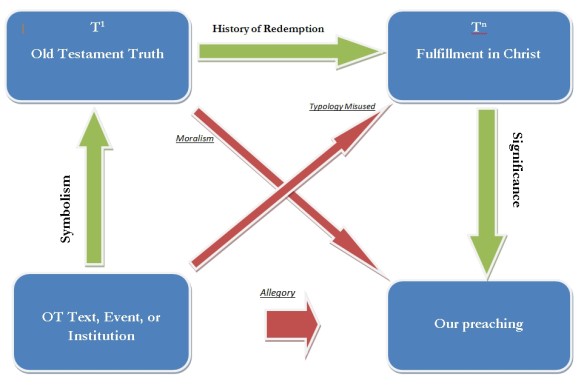Clowney's Diagram for Preaching from the Old Testament
Edmund P. Clowney was Professor of Pastoral Theology and President (for sixteen years) of Westminster Theological Seminary. Clowney was a leader in the historical-grammatical interpretation resurgence in the last half of the twentieth century that emphasized a Christocentric approach to interpreting Scripture. He has influenced men such as Bryan Chapell, Timothy Keller, and Dennis Johnson. His teaching on preaching Christ in the whole of the Bible, with a particular emphasis on how that is done in the Old Testament, has in many ways become the “gold standard” by which others on this subject are judged. His book, Preaching Christ in All of Scripture, published toward the end of his life, captures the essence of his teaching.
Preaching Christ in All of Scripture is a relatively brief work of less than two hundred pages. The book consists of three primary parts. First, Clowney takes the words of Jesus in Luke 24:44-45 regarding how all the Scriptures are about Christ, and then shows how that should influence our interpretation of the Bible. Next, he explains how to develop a sermon which leads the hearers to an encounter with Christ. Lastly, and most richly, thirteen of Clowney’s own sermons are included where he demonstrates ably and warmly how this type of preaching is done.
Clowney, after interacting with other scholars on this subject, develops his approach. One part especially helpful is where he highlights how to move from events and institutions in the Old Testament that foreshadow Christ to a proper way of proclaiming him by using the following illustration. The idea is to follow the green "Go" arrows.

With this diagram, he begins in the lower left-hand corner and draws an arrow upward to represent developing the symbolism of the event or institution through proper study for sermon creation. From that truth, he takes the arrow to the right along the top of the box to encourage the event being related to the broader context of the Bible’s story of the history of redemption in Christ. He then takes the arrow down the right side of the box to represent finding the significance of these truths for the congregation as we preach to them.
Clowney also demonstrates with this illustration how this process can be short-circuited in three ways (represented by the red "Stop" arrows).
- The first short circuit is by jumping straight from the event to preaching. This quick process creates allegorizing because of a failure to relate the symbol to the rest of Scripture. For instance, the preacher may be eager to see Christ in the story of David and Goliath, but may give fanciful interpretations to the details of David and his actions. For instance, you can read of people making unsubstantiated connections. such as David's use of one of the five stones he selected against Goliath picturing Christ quoting from one of the five books of the Law (Deuteronomy) in his temptations from Satan in the wilderness.
- The second way to cut short the true preaching of Christ is by going from the symbol’s development straight to preaching (the downward, diagonal red arrow). This failure to relate the symbol to Christ properly often creates moralizing. So David's bravery in the battle becomes the focal point of the story, the typology of Christ is not developed, and the moral lesson of having courage before one's own "giants" becomes the message preached.
- The third manner of improper symbol development is represented by the upward, diagonal red arrow on the diagram. Instead of looking more fully at how the symbol is used in the Old Testament, the interpreter skips to how it is fulfilled in Christ. Then the fullness of the typology is lacking. Using David and Goliath again, one might recognize that David slaying Goliath is similar to Christ defeating the evil one. However, the correlation of such things as David arising as an unrecognized but anointed king from Bethlehem being like Christ, or Goliath's description in serpent-like terms sounding reminiscent of Satan, could be overlooked.
Dr. Clowney’s illustration helps guide the preacher toward a faithful declaration of Christ. His book, with its final section of his sermons an illustration itself of this type of preaching, is certainly worth having on one's bookshelf, whether to help in sermon preparation or to learn how to evaluate the faithfulness of preaching.
